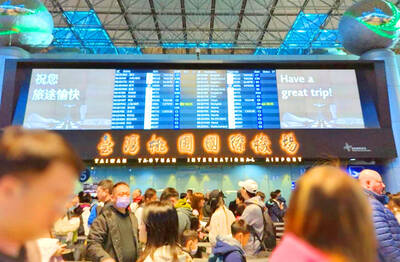Convinced that the Truku tribe of Hualien County evolved differently from its Sedeq ancestors in Nantou County, Tera Yudau (
Tera Yadau, who's Chinese name is Lee Chih-shoon (

TAIPEI TIMES FILE PHOTO
The council is preparing to contract an ethnologist to study the tribe's pedigree, language and social system in a bid to grant the Truku people's wish to restore their dignity.
According to Lin Chiang-i (林江義), director of the council's Planning Department, the council will present draft amendments to a measure regarding the recognition of Aboriginal tribes to the Cabinet for ratification today.
Among other things, the draft would expand the members of the review committee from 10 to between 17 and 23 to make the review mechanism of the nation's Aboriginal tribes more complete.
"The reason behind this is to include ethnologists, anthropologists and politically-neutral social elite on the committee panel," Lin said. "By doing so, we hope the mechanism would function more impartially and objectively."
The committee at present consists of 10 representatives from the nation's 10 officially recognized sub-tribes of the Kaoshan Aboriginal people.
The Kaoshan tribes, as opposed to the Pingpu tribes, are indigenous people living in the mountainous areas.
The Pingpu tribes refer to the indigenous people living on the plains and their cultures and life-styles were greatly influenced by the Han immigrants who arrived on the island during the course of the 17th century.
The Chinese immigrants used "Pingpu Fan" (
Unlike the Aborigines living in mountain areas, who lived from hunting, the Pingpu are described in historical documents as fishermen, with few agricultural skills.
Over the centuries, the Pingpu intermarried with Han Chinese and most of their language and customs were lost.
Like the Kaoshan Aborigines' 10 sub-tribes -- all of which have already been recognized as official tribes -- the Pingpu people also consist of 10 sub-tribes.
The 10 recognized Kaoshan Aboriginal tribes are the Atayal, Saisiyat, Bunun, Tsou, Paiwan, Rukai, Puyuma, Amis, Tao and Thao.
The 10 Pingpu tribes are the Kavalan, Ketagalan, Makattao, Taokas, Pazzehe, Vupuran, Poavosa, Arikun, Lloa and Siraiya.
Following the government's recognition of the Thao as the nation's 10th official Aboriginal tribe in 2001, the Cabinet last year approved a proposal presented by the Aboriginal Council to recognize the Kavalan people as the nation's 11th Aboriginal tribe.
Commenting on Tera Yudau's request, Lin said that the council will handle the matter carefully and in accordance with the due process of the law.
"This is a serious and important issue. We respect the tribe's ethnic consciousness and will remain impartial and neutral while handling the matter," Lin said.
According to Lin, more information is still needed for the official recognition of an Aboriginal tribe in addition to the tribe's wish to become one.
"In this case, it's obvious that most of the tribe's people in Hualien County want to be recognized as Truku," Lin said.
"However, we still need to know more about their pedigree, demography, cultural uniqueness and language to see whether they really stand out and are different from other indigenous tribes."
Tera Yudau, superintendent of the Yutong Junior High School, said that Hualien County's Truku tribe has long been incorrectly categorized as part of the Atayal tribal system and has evolved very differently from its ancestors, the Sedeq.
"The mistake has its origin in the Japanese colonial era when the Japanese ethnologists wrongfully categorized the Atayal and Sedeq tribes as one because both of the tribes' people had facial tattoos," he said.
He also opposed to the idea of naming his tribe as Sedeq, because of cultural considerations.
"`Sedeq' in our language means third person and the outer self, while `Truku' means first person and the inner self as well as those men who are brave, honest, generous and kind and those women who are good at weaving, house chores and loyal to their husbands," he said.
This is part one of a two-part series. Part two will be published later this week.

Three Taiwanese airlines have prohibited passengers from packing Bluetooth earbuds and their charger cases in checked luggage. EVA Air and Uni Air said that Bluetooth earbuds and charger cases are categorized as portable electronic devices, which should be switched off if they are placed in checked luggage based on international aviation safety regulations. They must not be in standby or sleep mode. However, as charging would continue when earbuds are placed in the charger cases, which would contravene international aviation regulations, their cases must be carried as hand luggage, they said. Tigerair Taiwan said that earbud charger cases are equipped

Foreign travelers entering Taiwan on a short layover via Taiwan Taoyuan International Airport are receiving NT$600 gift vouchers from yesterday, the Tourism Administration said, adding that it hopes the incentive would boost tourism consumption at the airport. The program, which allows travelers holding non-Taiwan passports who enter the country during a layover of up to 24 hours to claim a voucher, aims to promote attractions at the airport, the agency said in a statement on Friday. To participate, travelers must sign up on the campaign Web site, the agency said. They can then present their passport and boarding pass for their connecting international

Temperatures in northern Taiwan are forecast to reach as high as 30°C today, as an ongoing northeasterly seasonal wind system weakens, the Central Weather Administration (CWA) said. CWA forecaster Tseng Chao-cheng (曾昭誠) said yesterday that with the seasonal wind system weakening, warmer easterly winds would boost the temperature today. Daytime temperatures in northern Taiwan and Yilan County are expected to range from 28°C to 30°C today, up about 3°C from yesterday, Tseng said. According to the CWA, temperature highs in central and southern Taiwan could stay stable. However, the weather is expected to turn cooler starting tonight as the northeasterly wind system strengthens again

Taiwan sweltered through its hottest October on record, the Central Weather Administration (CWA) said yesterday, the latest in a string of global temperature records. The main island endured its highest average temperature since 1950, CWA forecaster Liu Pei-teng said. Temperatures the world over have soared in recent years as human-induced climate change contributes to ever more erratic weather patterns. Taiwan’s average temperature was 27.381°C as of Thursday, Liu said. Liu said the average could slip 0.1°C by the end of yesterday, but it would still be higher than the previous record of 27.009°C in 2016. "The temperature only started lowering around Oct. 18 or 19